University Nursing: Horizontal Bullying During Transition Report
VerifiedAdded on 2023/04/23
|6
|1018
|394
Report
AI Summary
This report examines horizontal bullying, or lateral violence, in the context of nursing transitions. It defines horizontal bullying as derogatory behavior among colleagues in similar hierarchical positions, focusing on the experiences of newly registered nurses. The report explores the 'why' and 'how' of this issue, discussing how it can manifest through rude or abusive treatment, potentially stemming from experienced nurses' perceptions of new nurses as threats. It details the negative consequences of horizontal bullying, including feelings of discouragement, burnout, and patient care errors, while also discussing the violation of the NMBA standards. The report then proposes solutions, such as consulting supervisors, practicing self-care, and adhering to NMBA standards for self-reflection to mitigate the impact of bullying and promote a safe work environment.
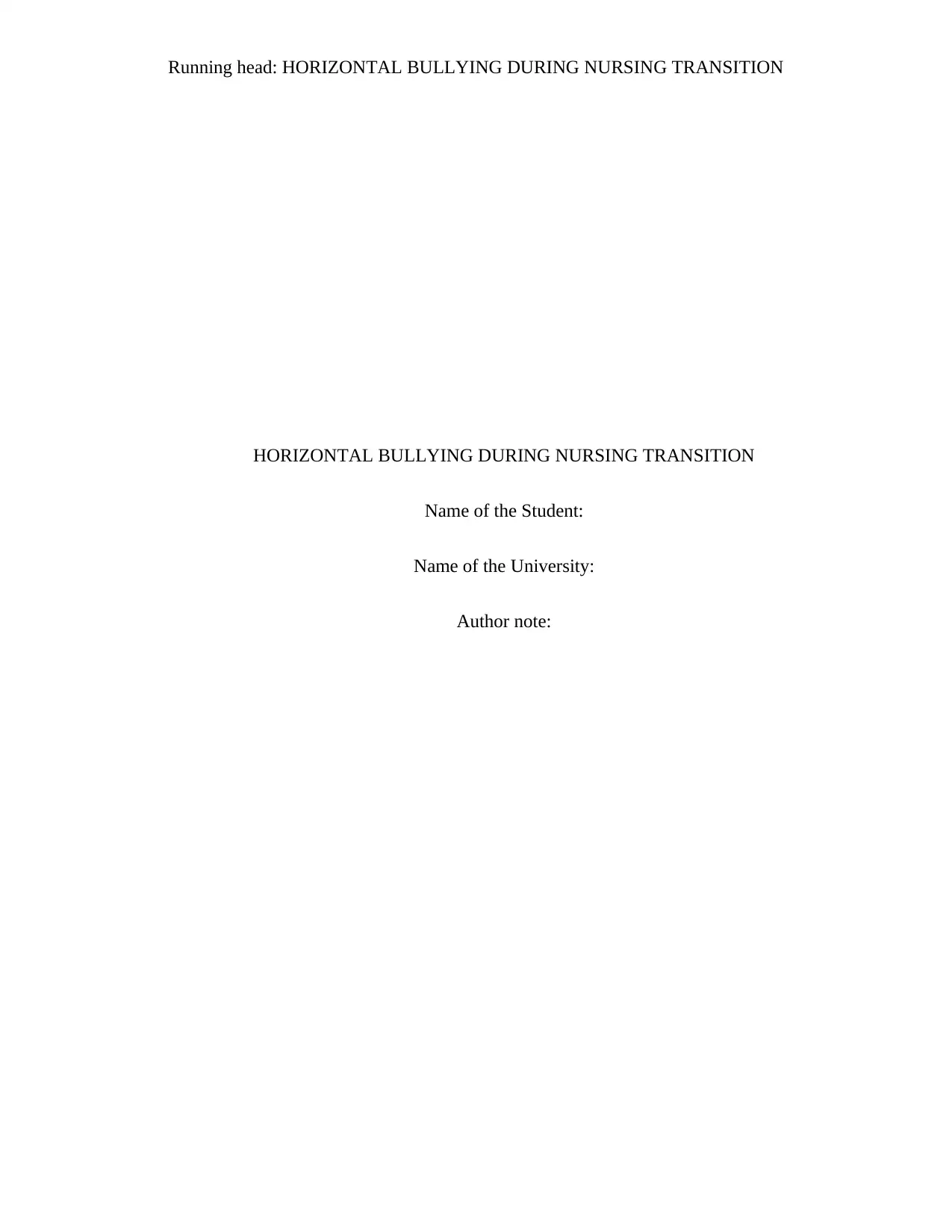
Running head: HORIZONTAL BULLYING DURING NURSING TRANSITION
HORIZONTAL BULLYING DURING NURSING TRANSITION
Name of the Student:
Name of the University:
Author note:
HORIZONTAL BULLYING DURING NURSING TRANSITION
Name of the Student:
Name of the University:
Author note:
Paraphrase This Document
Need a fresh take? Get an instant paraphrase of this document with our AI Paraphraser
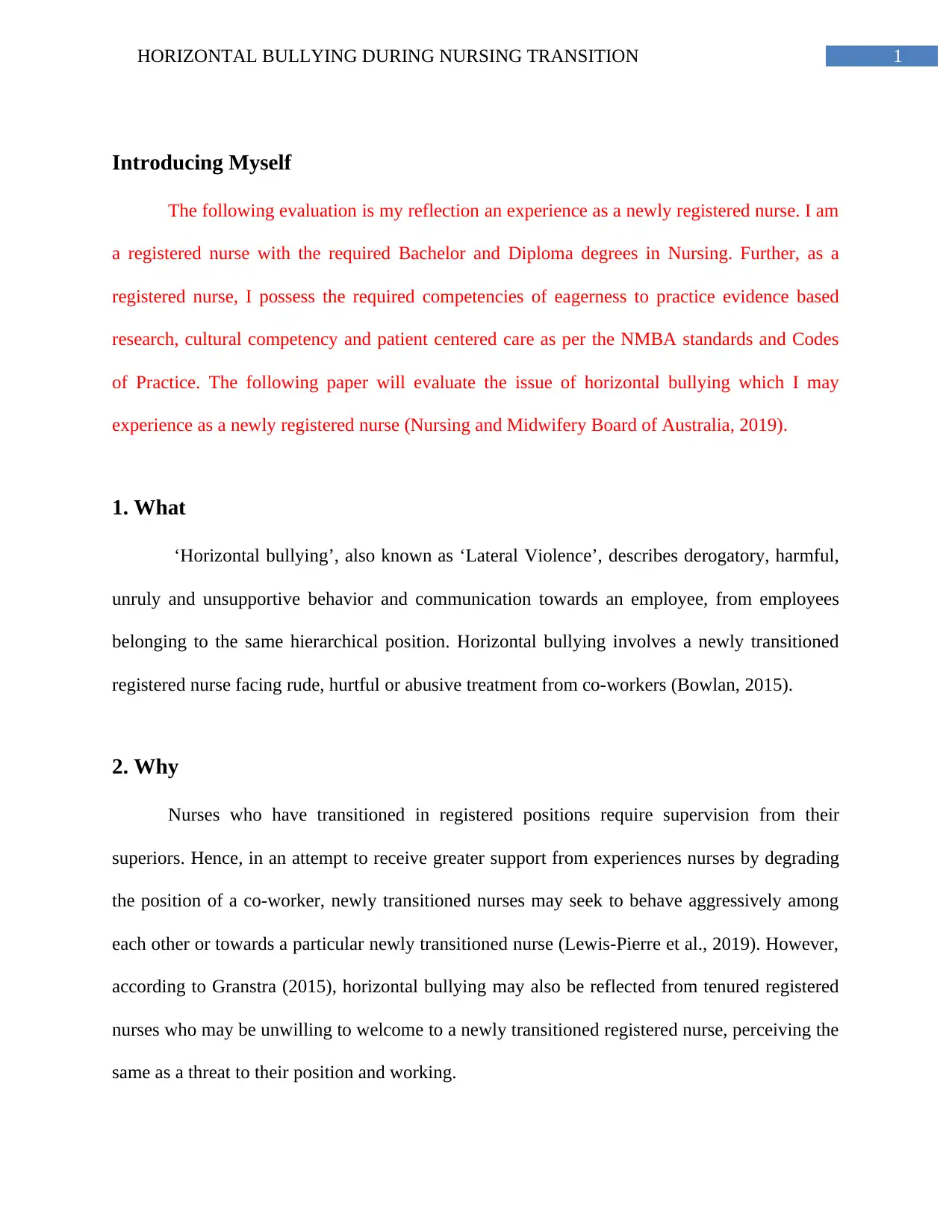
1HORIZONTAL BULLYING DURING NURSING TRANSITION
Introducing Myself
The following evaluation is my reflection an experience as a newly registered nurse. I am
a registered nurse with the required Bachelor and Diploma degrees in Nursing. Further, as a
registered nurse, I possess the required competencies of eagerness to practice evidence based
research, cultural competency and patient centered care as per the NMBA standards and Codes
of Practice. The following paper will evaluate the issue of horizontal bullying which I may
experience as a newly registered nurse (Nursing and Midwifery Board of Australia, 2019).
1. What
‘Horizontal bullying’, also known as ‘Lateral Violence’, describes derogatory, harmful,
unruly and unsupportive behavior and communication towards an employee, from employees
belonging to the same hierarchical position. Horizontal bullying involves a newly transitioned
registered nurse facing rude, hurtful or abusive treatment from co-workers (Bowlan, 2015).
2. Why
Nurses who have transitioned in registered positions require supervision from their
superiors. Hence, in an attempt to receive greater support from experiences nurses by degrading
the position of a co-worker, newly transitioned nurses may seek to behave aggressively among
each other or towards a particular newly transitioned nurse (Lewis-Pierre et al., 2019). However,
according to Granstra (2015), horizontal bullying may also be reflected from tenured registered
nurses who may be unwilling to welcome to a newly transitioned registered nurse, perceiving the
same as a threat to their position and working.
Introducing Myself
The following evaluation is my reflection an experience as a newly registered nurse. I am
a registered nurse with the required Bachelor and Diploma degrees in Nursing. Further, as a
registered nurse, I possess the required competencies of eagerness to practice evidence based
research, cultural competency and patient centered care as per the NMBA standards and Codes
of Practice. The following paper will evaluate the issue of horizontal bullying which I may
experience as a newly registered nurse (Nursing and Midwifery Board of Australia, 2019).
1. What
‘Horizontal bullying’, also known as ‘Lateral Violence’, describes derogatory, harmful,
unruly and unsupportive behavior and communication towards an employee, from employees
belonging to the same hierarchical position. Horizontal bullying involves a newly transitioned
registered nurse facing rude, hurtful or abusive treatment from co-workers (Bowlan, 2015).
2. Why
Nurses who have transitioned in registered positions require supervision from their
superiors. Hence, in an attempt to receive greater support from experiences nurses by degrading
the position of a co-worker, newly transitioned nurses may seek to behave aggressively among
each other or towards a particular newly transitioned nurse (Lewis-Pierre et al., 2019). However,
according to Granstra (2015), horizontal bullying may also be reflected from tenured registered
nurses who may be unwilling to welcome to a newly transitioned registered nurse, perceiving the
same as a threat to their position and working.
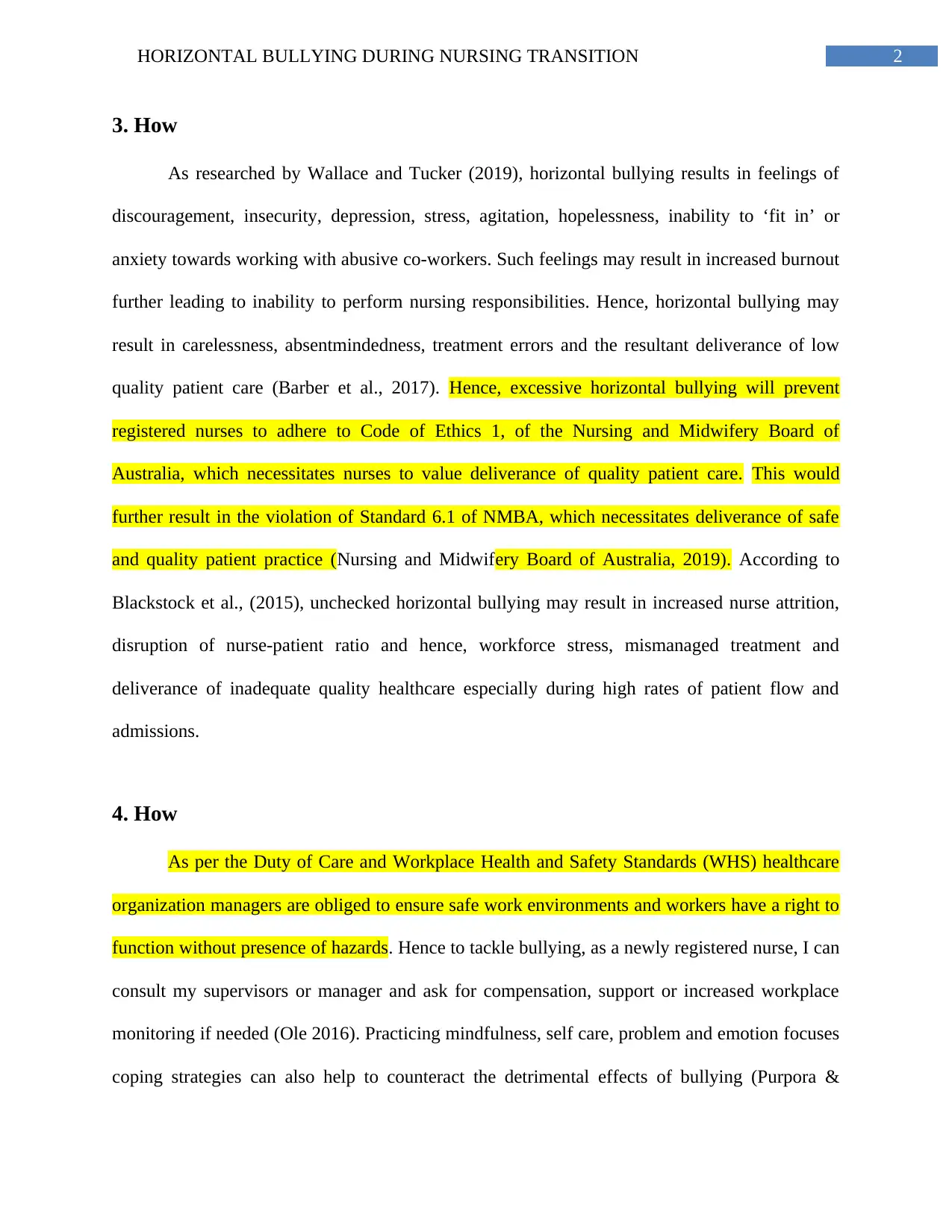
2HORIZONTAL BULLYING DURING NURSING TRANSITION
3. How
As researched by Wallace and Tucker (2019), horizontal bullying results in feelings of
discouragement, insecurity, depression, stress, agitation, hopelessness, inability to ‘fit in’ or
anxiety towards working with abusive co-workers. Such feelings may result in increased burnout
further leading to inability to perform nursing responsibilities. Hence, horizontal bullying may
result in carelessness, absentmindedness, treatment errors and the resultant deliverance of low
quality patient care (Barber et al., 2017). Hence, excessive horizontal bullying will prevent
registered nurses to adhere to Code of Ethics 1, of the Nursing and Midwifery Board of
Australia, which necessitates nurses to value deliverance of quality patient care. This would
further result in the violation of Standard 6.1 of NMBA, which necessitates deliverance of safe
and quality patient practice (Nursing and Midwifery Board of Australia, 2019). According to
Blackstock et al., (2015), unchecked horizontal bullying may result in increased nurse attrition,
disruption of nurse-patient ratio and hence, workforce stress, mismanaged treatment and
deliverance of inadequate quality healthcare especially during high rates of patient flow and
admissions.
4. How
As per the Duty of Care and Workplace Health and Safety Standards (WHS) healthcare
organization managers are obliged to ensure safe work environments and workers have a right to
function without presence of hazards. Hence to tackle bullying, as a newly registered nurse, I can
consult my supervisors or manager and ask for compensation, support or increased workplace
monitoring if needed (Ole 2016). Practicing mindfulness, self care, problem and emotion focuses
coping strategies can also help to counteract the detrimental effects of bullying (Purpora &
3. How
As researched by Wallace and Tucker (2019), horizontal bullying results in feelings of
discouragement, insecurity, depression, stress, agitation, hopelessness, inability to ‘fit in’ or
anxiety towards working with abusive co-workers. Such feelings may result in increased burnout
further leading to inability to perform nursing responsibilities. Hence, horizontal bullying may
result in carelessness, absentmindedness, treatment errors and the resultant deliverance of low
quality patient care (Barber et al., 2017). Hence, excessive horizontal bullying will prevent
registered nurses to adhere to Code of Ethics 1, of the Nursing and Midwifery Board of
Australia, which necessitates nurses to value deliverance of quality patient care. This would
further result in the violation of Standard 6.1 of NMBA, which necessitates deliverance of safe
and quality patient practice (Nursing and Midwifery Board of Australia, 2019). According to
Blackstock et al., (2015), unchecked horizontal bullying may result in increased nurse attrition,
disruption of nurse-patient ratio and hence, workforce stress, mismanaged treatment and
deliverance of inadequate quality healthcare especially during high rates of patient flow and
admissions.
4. How
As per the Duty of Care and Workplace Health and Safety Standards (WHS) healthcare
organization managers are obliged to ensure safe work environments and workers have a right to
function without presence of hazards. Hence to tackle bullying, as a newly registered nurse, I can
consult my supervisors or manager and ask for compensation, support or increased workplace
monitoring if needed (Ole 2016). Practicing mindfulness, self care, problem and emotion focuses
coping strategies can also help to counteract the detrimental effects of bullying (Purpora &
⊘ This is a preview!⊘
Do you want full access?
Subscribe today to unlock all pages.

Trusted by 1+ million students worldwide
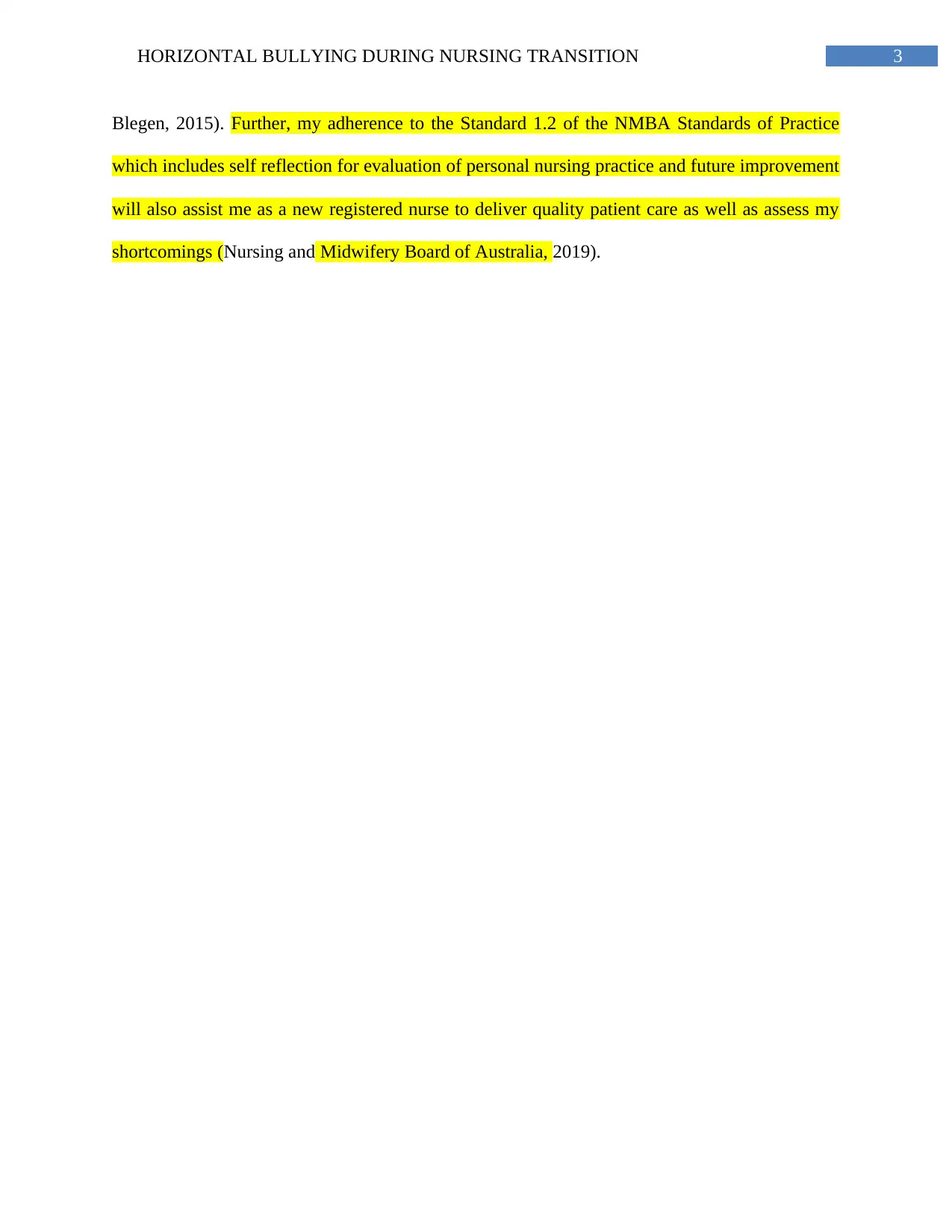
3HORIZONTAL BULLYING DURING NURSING TRANSITION
Blegen, 2015). Further, my adherence to the Standard 1.2 of the NMBA Standards of Practice
which includes self reflection for evaluation of personal nursing practice and future improvement
will also assist me as a new registered nurse to deliver quality patient care as well as assess my
shortcomings (Nursing and Midwifery Board of Australia, 2019).
Blegen, 2015). Further, my adherence to the Standard 1.2 of the NMBA Standards of Practice
which includes self reflection for evaluation of personal nursing practice and future improvement
will also assist me as a new registered nurse to deliver quality patient care as well as assess my
shortcomings (Nursing and Midwifery Board of Australia, 2019).
Paraphrase This Document
Need a fresh take? Get an instant paraphrase of this document with our AI Paraphraser
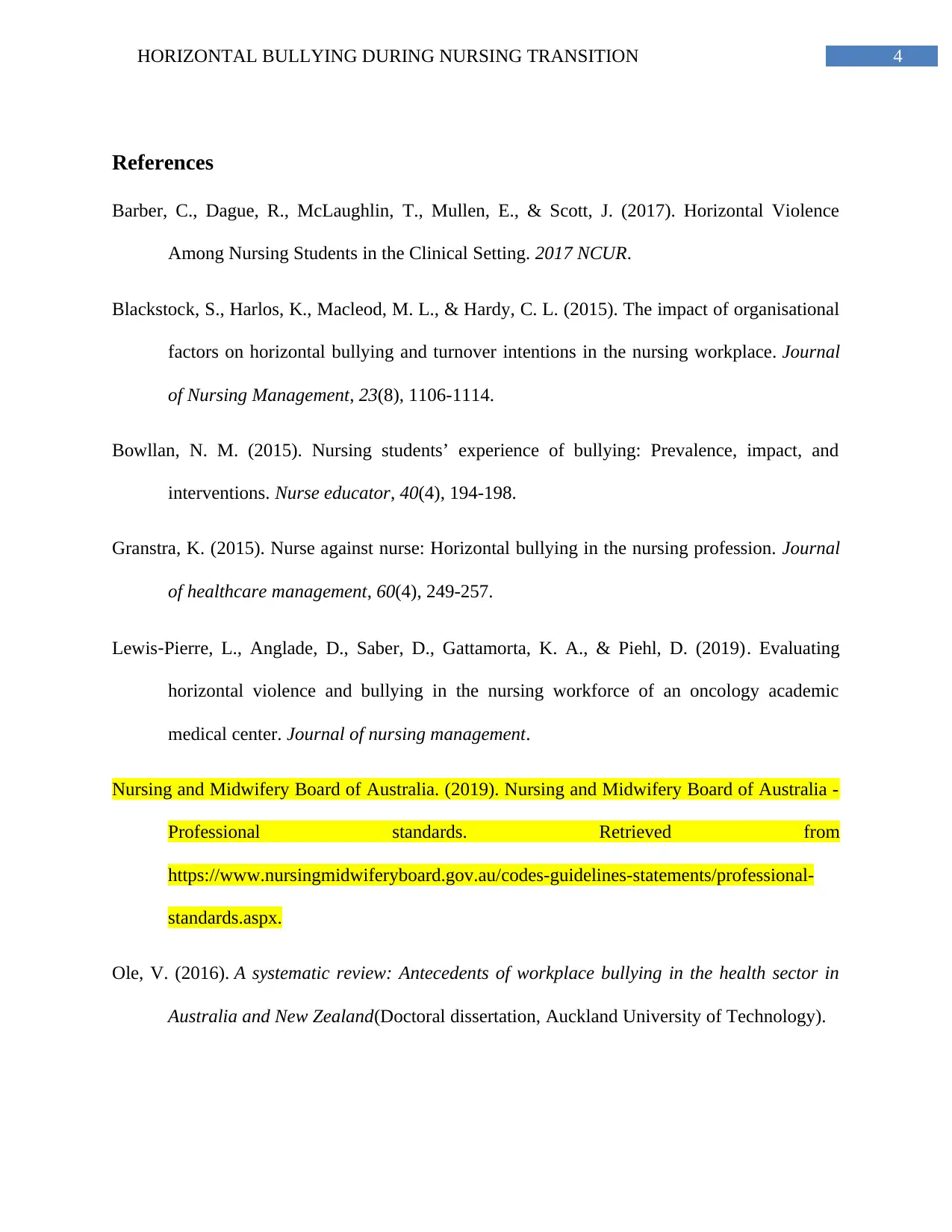
4HORIZONTAL BULLYING DURING NURSING TRANSITION
References
Barber, C., Dague, R., McLaughlin, T., Mullen, E., & Scott, J. (2017). Horizontal Violence
Among Nursing Students in the Clinical Setting. 2017 NCUR.
Blackstock, S., Harlos, K., Macleod, M. L., & Hardy, C. L. (2015). The impact of organisational
factors on horizontal bullying and turnover intentions in the nursing workplace. Journal
of Nursing Management, 23(8), 1106-1114.
Bowllan, N. M. (2015). Nursing students’ experience of bullying: Prevalence, impact, and
interventions. Nurse educator, 40(4), 194-198.
Granstra, K. (2015). Nurse against nurse: Horizontal bullying in the nursing profession. Journal
of healthcare management, 60(4), 249-257.
Lewis‐Pierre, L., Anglade, D., Saber, D., Gattamorta, K. A., & Piehl, D. (2019). Evaluating
horizontal violence and bullying in the nursing workforce of an oncology academic
medical center. Journal of nursing management.
Nursing and Midwifery Board of Australia. (2019). Nursing and Midwifery Board of Australia -
Professional standards. Retrieved from
https://www.nursingmidwiferyboard.gov.au/codes-guidelines-statements/professional-
standards.aspx.
Ole, V. (2016). A systematic review: Antecedents of workplace bullying in the health sector in
Australia and New Zealand(Doctoral dissertation, Auckland University of Technology).
References
Barber, C., Dague, R., McLaughlin, T., Mullen, E., & Scott, J. (2017). Horizontal Violence
Among Nursing Students in the Clinical Setting. 2017 NCUR.
Blackstock, S., Harlos, K., Macleod, M. L., & Hardy, C. L. (2015). The impact of organisational
factors on horizontal bullying and turnover intentions in the nursing workplace. Journal
of Nursing Management, 23(8), 1106-1114.
Bowllan, N. M. (2015). Nursing students’ experience of bullying: Prevalence, impact, and
interventions. Nurse educator, 40(4), 194-198.
Granstra, K. (2015). Nurse against nurse: Horizontal bullying in the nursing profession. Journal
of healthcare management, 60(4), 249-257.
Lewis‐Pierre, L., Anglade, D., Saber, D., Gattamorta, K. A., & Piehl, D. (2019). Evaluating
horizontal violence and bullying in the nursing workforce of an oncology academic
medical center. Journal of nursing management.
Nursing and Midwifery Board of Australia. (2019). Nursing and Midwifery Board of Australia -
Professional standards. Retrieved from
https://www.nursingmidwiferyboard.gov.au/codes-guidelines-statements/professional-
standards.aspx.
Ole, V. (2016). A systematic review: Antecedents of workplace bullying in the health sector in
Australia and New Zealand(Doctoral dissertation, Auckland University of Technology).
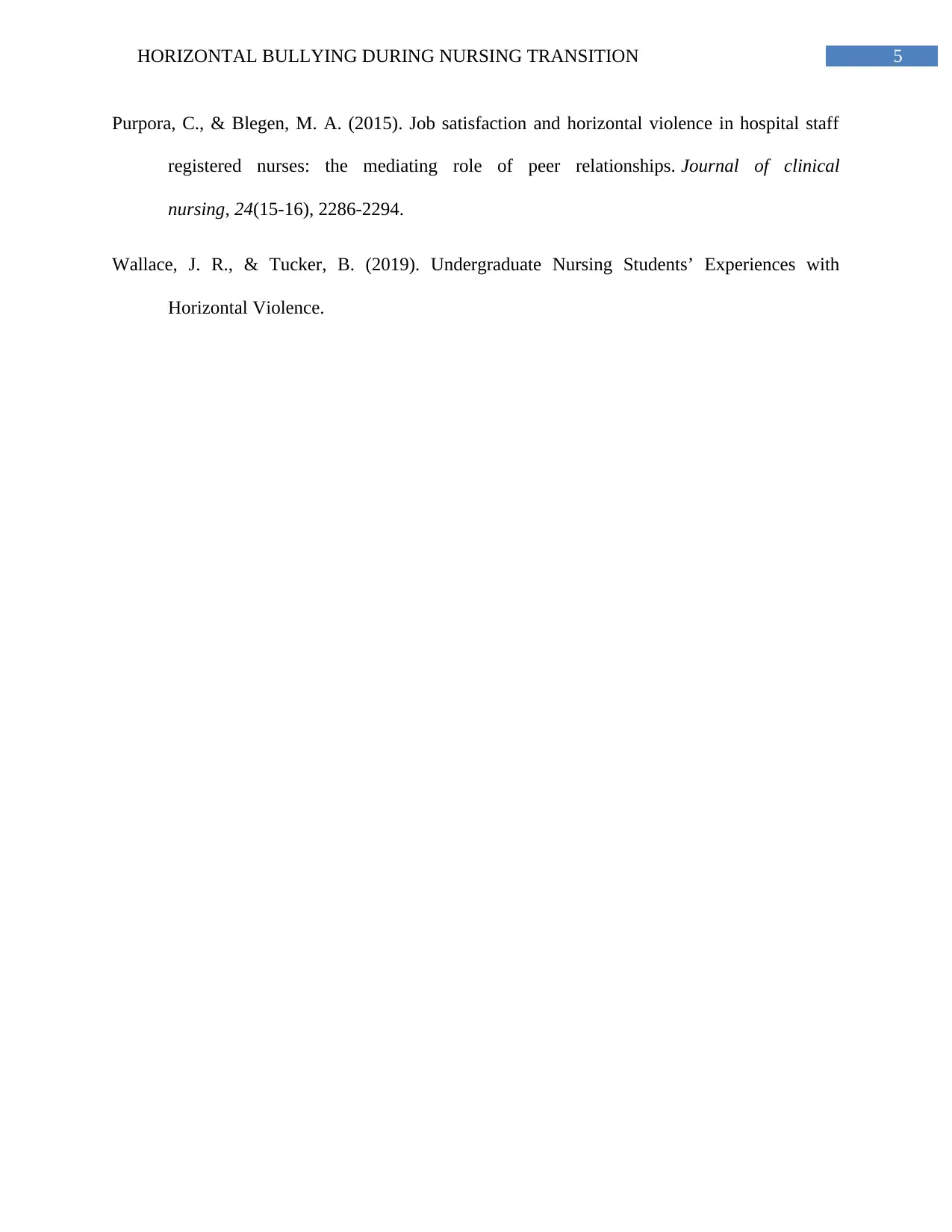
5HORIZONTAL BULLYING DURING NURSING TRANSITION
Purpora, C., & Blegen, M. A. (2015). Job satisfaction and horizontal violence in hospital staff
registered nurses: the mediating role of peer relationships. Journal of clinical
nursing, 24(15-16), 2286-2294.
Wallace, J. R., & Tucker, B. (2019). Undergraduate Nursing Students’ Experiences with
Horizontal Violence.
Purpora, C., & Blegen, M. A. (2015). Job satisfaction and horizontal violence in hospital staff
registered nurses: the mediating role of peer relationships. Journal of clinical
nursing, 24(15-16), 2286-2294.
Wallace, J. R., & Tucker, B. (2019). Undergraduate Nursing Students’ Experiences with
Horizontal Violence.
⊘ This is a preview!⊘
Do you want full access?
Subscribe today to unlock all pages.

Trusted by 1+ million students worldwide
1 out of 6
Related Documents
Your All-in-One AI-Powered Toolkit for Academic Success.
+13062052269
info@desklib.com
Available 24*7 on WhatsApp / Email
![[object Object]](/_next/static/media/star-bottom.7253800d.svg)
Unlock your academic potential
Copyright © 2020–2025 A2Z Services. All Rights Reserved. Developed and managed by ZUCOL.





